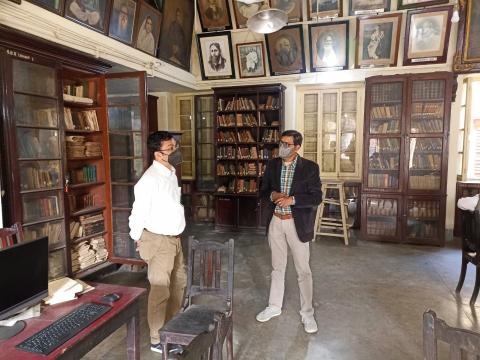Aims and objectives
This project will bring together an international team of scholars to create an inventory of approximately 6,000 Sanskrit, Bengali, and Prakrit palm-leaf and paper manuscripts held at the Rāmamālā Library in Comilla, Bangladesh. From this collection of unique materials, approximately 100-150 rare and vulnerable manuscripts will be rehoused and digitised. Scholars and students, both foreign and local, will index manuscript title, genres, size and condition, thus facilitating future assessments of the collection’s value and sustainability. Digital images of the selected items will be made freely available online to bring attention to the collection and laying the groundwork in training and infrastructure for a future major preservation and digitisation project.
The collection dates from approximately 1500-1900 AD. Established in 1935 by Maheśacandra Bhaṭṭācārya and currently run by the Mahesh Charitable Trust, the collection was meant to promote education and preserve Bengali culture. It was also intended as a resource for preserving and promoting Hinduism within a dominant Muslim environment on the eve of British colonialism. Much of the library is thus dedicated to Sanskrit scientific and legal literature. Yet it also contains unique texts in a variety of other Sanskrit genres and includes many regional works in Bengali (eg, a rare version of the Mahābhārata), together with some works in Prakrit. Consequently, it preserves a snapshot of the literary and religious culture of the region in pre-colonial and colonial times, encompassing not just Hindu works but also works related to a distinctive, regional variety of Islam (Satyapīr).
The collection has been physically displaced twice. First during the upheavals in 1947 when India and Pakistan were partitioned, and then again in 1971 when Bangladesh broke away from Pakistan. Early attempts to itemise, catalogue, and identify manuscripts have been largely lost; all that remains by means of a catalogue is a general overview of the collection and archives of a few handwritten notes. The manuscripts themselves suffer from physical neglect and dilapidation. They are housed in rooms with glassless windows and leaky roofs, exposed to the elements, and open to vermin and potential theft. The current librarian who looks after the collection is elderly and in poor health. It is urgent to begin initial steps to help preserve this valuable collection and disseminate knowledge about its contents and to help protect it against the ravages of South Asian climate.
Since Bangladeshi independence, there have been limited efforts to ameliorate the disarray of manuscripts, including some microfilming in the 1980s, and classification of the manuscripts’ general categories. Despite the promise of these preliminary efforts, the full scope of the collection remains unknown.
Training of local students and scholars will be done through workshops held at the Rāmamālā Library, and will focus on technical aspects and skills of gathering and recording primary material, such as digitisation, source data collection, and preservation. This training will be geared towards this pilot project but will also facilitate the future continuation and expansion of digital projects at this site. Thus, for instance, through the workshops, scholars and students from the surrounding region will learn basic techniques of professional digitisation of manuscripts using high-quality camera equipment as well as how to process the data with institutional-level workflow software. They would also be trained on basic source data collection to render useable, descriptive details from manuscripts (palaeography, content, physical description) and to convert this information into data files using xml. Training initiatives will thus help to establish a sustainable knowledge-base for regional scholars.
This pilot project will establish a foundational inventory that will serve as the basis for assessing its value and setting up more extensive projects. 100-150 rare and at-risk manuscripts will be digitised and made available online.
Outcomes
This project set out to create an inventory of 6000 primarily Sanskrit and Bengali manuscripts held in the Rāmamālā Trust compound in Comilla, Bangladesh, and to digitise a sample of them. The project found that there were far more manuscripts in the collection than initially thought, with an estimated 9000 in total. This discovery added a significant strain on resources for creating the inventory and managing their assessment, however, the team were able to complete their work, converting handwritten lists into spreadsheets, and make the inventory readily available to scholars worldwide. The project was also able to digitise a sample of 85 manuscripts ranging from 1 folio up to 620 folios in length dating from the mid-17th century up until the early 20th century. The project also carried out preservation work on many of the endangered manuscripts and moved them to less exposed locations away from vermin and water leaks.
The records copied by this project have been catalogued as:
- EAP683/1 Rāmamālā Library manuscript project
Due to the cyber-attack on the British Library in October 2023, the archives and manuscripts database is currently inaccessible and we are unable to provide links to the catalogue records for this project.


